#fairy tale analysis
Text
The Tale of the Golden Snail (a Fairy Tale from the East with Curse element in it)
Before going deeper, I want to say that CPC depictions is lacking eastern (Asia and Africa - and maybe southern America as well?) fairy tales that depicted on the media - the closest of the eastern tale depiction is the magic lamp from "Aladdin" which is from middle east asia. Jack finds the Braided Island that inhabitants with people with appearance that different than him, is also similar with how westerner see easterner folks [which either got amazed by their exotic appearance or horrified with them to point of being racist]. It's a shame IMHO because as someone from East, I want to say that Eastern Fairy Tales is a giant gem box that ready to be explored.. Especially from my own country, there's many fairy tales with curses on their story - like becomes animal (monkey, snail etc), petrified to becomes a stone (Malin Kundang) or born cursed (example, has face of a gourd). I like to introduce my own country and it's culture but without being posh doing it, slow and honest introduction by said my country as Batik Kingdom - islands based Kingdom from faraway place from the continent where Plaid-Pastel-Polygon Kingdom resides. I am headcannon-ing that Frederick reads fairy tale from faraway continent as well, based on ep 34:

Well, let's move on to next topic which is about the Golden Snail Tale!

Once upon a time, Daha was a prosperous kingdom under Prabu Kertamerta's reign (Prabu means a king in English). He had two beautiful daughters: Galuh Ajeng and Candra Kirana.
When these two princesses had come of age, a crown prince from the Kahuripan kingdom came to propose a marriage. Raden Inu Kertapati was a handsome, strapping crown prince from a prosperous kingdom, so Prabu Kertamerta welcomed him and accepted his proposal.
Despite Princess Galuh Ajeng being the eldest, Raden Inu Kertapati chose Princess Candra Kirana. It rose Princess Galuh's wrath. She plotted a devious plan to expel Candra Kirana from the palace so she couldn't marry Raden Inu Kertapati.
She sought an evil witch to cast a spell on her sister. She wished Candra Kirana became so disgusting that no one wanted to get near. Not long after that, the witch cast a spell on Candra Kirana to become a keong emas (a golden snail). Before she threw the snail into the river, she told the princess the curse could only be broken by meeting Raden Inu Kertapati. [Note: the curse is broken not by "True Love's Kiss" but could simply by meeting the beloved, this nice insight]
In another version of this tale, the one that cursed as golden snail actually a queen which got cursed as bad karma by bad mouthing a 'magical' golden snail that she founds at the street. I take the most popular version instead because the character's name fits better ("Kirana"). Kirana is my OC of my planned multiple chapters fanfic series, her summarized backstory as the following: A witch cursed her to becomes a golden snail every night and teleported her to far away place (similar with Thermidora's story) - the Male Monastery site.
Kirana meets Whitney and they're platonically becomes close - her ideal that every curse could be broken eventually leads Whitney to becomes a curse breaker [which very important as being the one that recognize Frederick's curse properly]. Meanwhile Kirana go to get more informations and money so she could return to her kingdom someday, by becoming a journalist/reporter. This will be important plot point later on

^ How I imagined Kirana looks like, with her kingdom's outfit - Batik - and blonde hair which similar with her curse. Credit of the art piece with the watermark on the upper part
One day, a poor old lady caught a snail on her fishing net. When she saw it was a beautiful golden snail, she brought it home and kept it in a crock (an earthenware pot).
The next day the old lady went fishing. Unfortunately, she only caught a few fish. She was devastated because she could only buy a bit of rice. Imagine her surprise when she found plenty of food on her dining table. Feeling so hungry, she ate them without asking questions. Since this bizarre experience occurred every day, one day, the old lady pretended to go fishing. Then, she sneaked back into her hut and found a beautiful maiden cooked and cleaned.
She immediately confronted the maiden, who happened to be the cursed Princess Candra Kirana. As soon as the princess told her story, she became Keong Emas (golden snail) again. That's the beginning of the friendship between Candra Kirana and the old lady.
In the meantime, the news of the missing princess spread throughout the kingdom of Daha. Feeling that she had no other competitors, Princess Galuh Ajeng tried her hardest to replace her sister as the bride of Raden Inu Kertapati.
However, since Raden Inu Kertapati was deeply in love with Candra Kirana, he set off on a journey to find her. Knowing this, the evil witch shapeshifted into a crow and followed him.
When the crow talked to him in human language, Raden Inu Kertapati was amazed. He believed it was a magical creature that could help him found Candra Kirana. So, he followed the crow's leads. He didn't realize that the crow led him further away from Candra Kirana.
One day, Raden Inu Kertapati met an elderly, who asked for some food. Being the kind person he was, the prince happily shared his food. It turned out that the elderly was a wise man; who knew the evil crow had tricked the prince. So, as a payback to the prince's kindness, he hit the crow until it evaporated into a puff of smoke. Then he told him where to find Candra Kirana.
Thus, Raden Inu Kertapati set off to Dadapan village. It was a long journey. Several days later, the prince ran out of provisions, so he approached the closest house to ask for water. Imagine his delight when he saw Candra Kirana was cooking in there. He rushed into the house, and their reunion broke the curse.
Soon the couple returned to the kingdom of Daha and told the misfortune of Candra Kirana. Afraid of King's wrath, princess Galuh ran to the woods. That's the last time anyone heard of her.
In the end, Raden Inu Kertapati and Candra Kirana lived happily ever after. They invited the old lady to live in the palace and took care of her.
3 notes
·
View notes
Text
The Snow Queen: Story the Second: A Little Boy and a Little Girl
So part two is where things really get going. It’s where we meet Kai, Gerda, the grandmother, and the Snow Queen. This is the only section that really focuses on Kai, before he spends the next four sections missing.
I did take a lot of inspiration from this section for my book—the snow bees, the shared garden with the rose bush, the houses right close together. The emphasis, moving forward, on roses or bees. Kai’s skill for mimicry and mathematics.
This section opens by introducing us to Kai and Gerda. Then it introduces us to the idea of the Snow Queen, in a story that comes from Kai’s grandmother. She’s telling the children about snowflakes, describing them as snow bees, and Kai asks if they have a queen, like real bees. Grandma tells him that they do—the Snow Queen.
It’s important to note the grandmother doesn’t describe the Snow Queen as a villain or a threat—just the queen of the snow bees.
It’s unclear why Kai threatens to melt her on the stove—he doesn’t have the mirror shard to make him cruel yet, and she isn't described as someone who needs to be done away with. Maybe it’s just him being a little boy; they can be jerks sometimes.
Kai sees the Snow Queen in his window that night, and the next day, spring comes. In the spring, the shards of our evil, enchanted mirror from part one fly into Kai—one in his eye, one in his heart. These instantly distort the way Kai sees the world, and make him cruel. They also, oddly, instill in him a love for snowflakes.
When the winter comes again, Kai is taken by the Snow Queen. For a given value of “taken.”
She rides through the town square on her sleigh, and Kai hooks his sled (Gerda’s, actually—he borrowed it) onto the back. He doesn’t ask for permission to do this. He doesn’t interact with her at all until she’s ridden back out of town, pulling him along. At this point he considers unhooking himself, but she signals that he should stay, so he does.
At one point, he becomes afraid, and tries to pray, but he can’t remember how. He can only remember math.
Eventually, the Snow Queen brings him up into her sleigh. She kisses him, which completes the process, already started by the mirror, of freezing his heart. Then she stops kissing him, saying any more would kill him--apparently your heart can only freeze so much before it’s unsafe.
I don’t think this is, like, creepy. The kisses aren’t…inappropriate. We aren’t meant to read anything into them. Especially taking into account the equally non-romantic kisses we’ll see in part seven. These kisses are just the method by which the ice is spread.
Kai’s gotten over his gear by this point, and he no longer feels cold. We close out part two on him bragging to the Snow Queen about all the math he can do, as they ride off into the winter together.
6 notes
·
View notes
Note
I'm so tired of people saying that the Prince from Snow White is a creep for kissing Snow White when he thought she was dead.
People act as if he put his tongue down her throat while she looks like a regular corpse.
Maybe I'm just more comfortable with death because of my upbringing.
There's a European tradition that you would kiss dead people goodbye. You would also wait with a dying person because dying alone was one of the most horrible ways to die.
In Poland, you would spend three days with the dead body of your relative in the house so family and friends have time to say goodbyes. We even have pictures of family members in coffins, so we could remember them.
Yeah, it's a very post-modern, historically, culturally-small-minded way to look at it.
Specifically in this movie (which is a fairy tale's fairy tale) people just...totally ignore the scene where The Prince is introduced.
Seriously and truthfully, BECAUSE the Prince only takes action in three scenes of the movie, you HAVE to take all three of them very very seriously. Because thats all there is to know about him. That's how fairy tales work: lots of information hiding under very brief, simple snippets of information. It's called nuance.
Anyway.
The Prince kisses Snow White as a culmination of their promised love for each other.
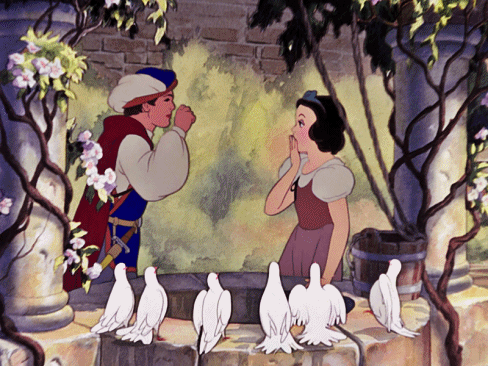
First scene he's in, he falls in love with her because of her obvious purity and he overhears her longing for someone to love her. Then she runs away because she's not sure of him, and doesn't know him. But he sings his part of the song, which is all about how he has just one heart to give, one devotion to spend, and he's choosing to give it and spend it on her if she'll have him.
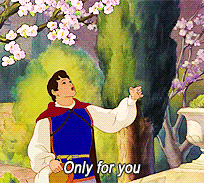
And she will have him. How do we know? She sends a kiss to him on the dove. That's how the exchange ends; that's how she responds, and that's why he leaves satisfied. It's their engagement scene. They're promising their hearts to each other.
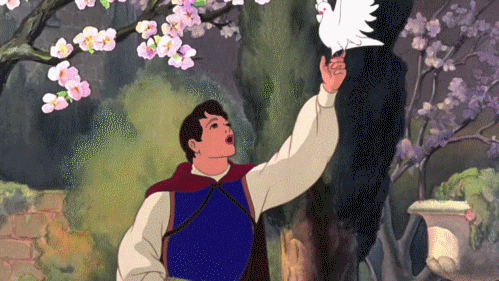
Fast-forward, the Queen messes up what might have been the natural follow-through of that engagement which is marriage by trying to kill Snow White, she's living in the woods, but she won't forget the Prince and wholeheartedly believes he'll come find her.

And the very next thing we hear about him is that he keeps his promise. He's got one heart, one love, one devotion, and it's promised to Snow White, and he will not stop searching for her. When he finds her, he's returning her kiss from their engagement scene. He thinks she's dead, but he has to finish his quest anyway. This is him, trying to keep his promise even if she's dead; he's trying to fulfill the exchange they had when they saw each other last.
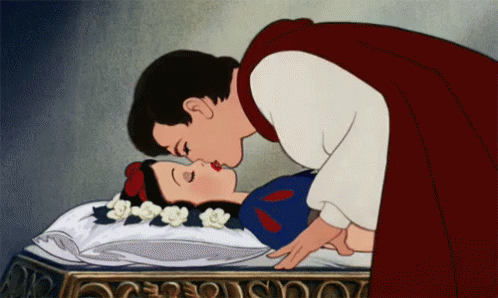
It's ridiculous to assume that she needed to be awake and alive to give permission for him to kiss her; it's ignorant of the whole relationship, symbolic and literal, between these two fairy tale characters. She already sent him her kiss and her heart; he already promised to claim it; he's fulfilling the promise in that scene.

Crazy postmodern people, don't know how to take in a story. Not everything gets to have your socio-cultural lens imposed upon it.
#Snow White and the seven dwarves#little graphic there#asked#answered#true love's kiss#discourse#Snow White.Snow White 2024#Snow White hate#Snow White and the seven dwarves 1937#snow white 1937#disney#classic films#meta#analysis#fairy tales#learn to read fairy tales
2K notes
·
View notes
Text
So I think we all understand at this point that much of the Fairy Tales of Remnant and various other in-universe folktales and legends that have been told or otherwise mentioned up to now are IMPORTANT. That these stories, particularly the ones that are given some kind of focus, are meant to relate to specific events or characters and generally foreshadow things that will happen or be revealed in the show. Whether in the direct sense of ‘this story is actually relating real events that are significant to characters’ like The Story of the Seasons to the Maidens and Oz, or in more indirect, symbolic fashion like Oscar and Ozpin idly discussing The Girl Who Fell Through the World in Volume 8.
Suffice to say, fairy tales in RWBY clearly MEAN something. Especially if a fairy tale is clearly being connected to a character or characters.
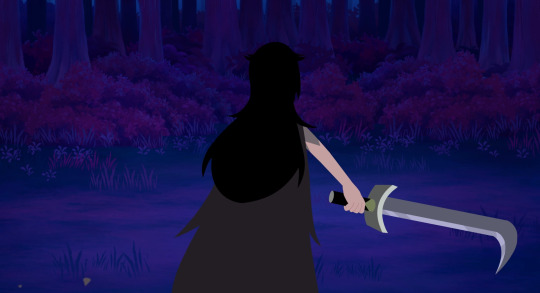
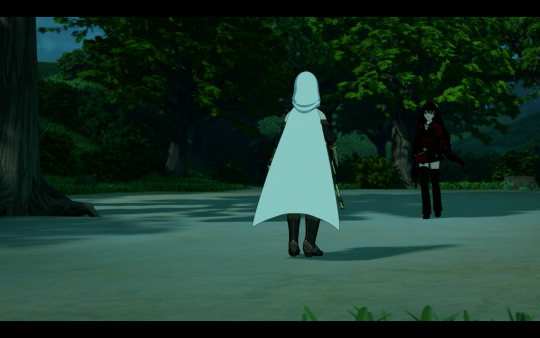
To that end, going forward I think we should really be looking at The Warrior in the Woods, and in-particular the animated short, as being narratively tied to Summer, Raven and Taiyang. And specifically meant to foreshadow what Taiyang’s relationship with Summer and Raven was REALLY like.
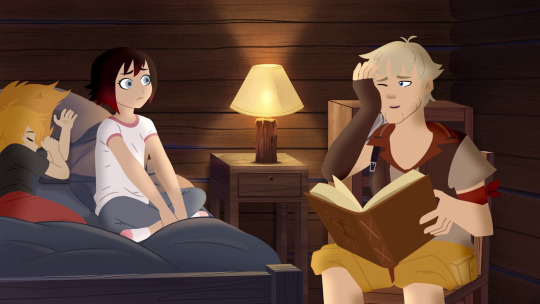

For one, the connection the animated short draws is not exactly subtle. The short is flat out framed as Tai reading the story to Ruby and Yang for bedtime, with the boy in the story looking like a young version of Tai while the titular Warrior looks literally like a combination of Summer and Raven. And to top it all off, the story even broadly reflects what we already know about the relationships of the three; with the young man losing the woman he so admired and loved just like Tai lost Summer and Raven. Again, the connections are not in ANY way subtle here.
So with that base established, what more can we potentially glean as foreshadowing here?
Well, as I’ve stated in previous posts, I think it is telling that while the Boy in the story did love the Warrior, it is ultimately a tragic, doomed love that was never meant to be.


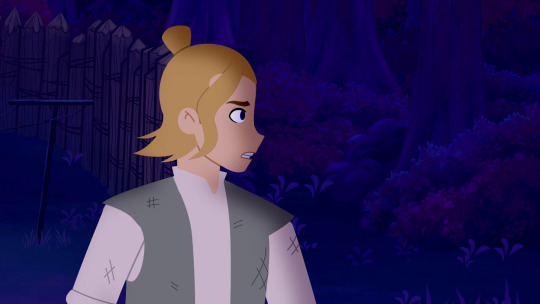
And more than that, the story notably only gives us the perspective of the boy, and never the Warrior. And likewise, we never learn how the Warrior truly felt about the boy. She clearly cared about him, enough to consider him something of a friend, but did she feel about him like he felt about her? The story never makes this clear, and I think that in and of itself is rather telling: Despite the boy’s attempts to reach out to her, the Warrior maintains her distance. Whatever growing care or affection she might have felt for the boy, it clearly wasn’t nearly enough to get her to break her isolation or duty to safeguard the village in secret. While the boy may have loved the Warrior, it was a love that in all likelihood, could not and was not returned.
So when we apply this to Taiyang, Summer and Raven, a rather bleak picture emerges: That Tai’s relationships with Raven or Summer were NEVER going to work out. Or that neither Summer NOR Raven actually loved Tai in the same way he loved either of them.
And the thing is, this IS supported even by what little we have seen of Tai, Summer and Raven. Just like in the story, we have been told of Tai’s love for Summer and Raven, yet told precious little of how either of THEM felt about Tai. And what little we HAVE been told or shown has left it rather questionable how either of them cared for Tai.
Raven has made it clear that she cares little for Taiyang in the present, which really raises the question of how or if the two were ever in a relationship in the past. And while the existence of Yang might imply some kind of relationship, let’s also consider the possibility that Yang was actually an unplanned pregnancy. The result of a possible drunken, one-night-stand between Raven and Tai. Which would certainly put Raven’s reluctance to be a mother in a VERY different context.

Then we have Summer, and thanks to Ruby’s tree-vision, I think we can count her feelings for Taiyang as being at best ‘ambiguous’.
For one, as I’ve stated elsewhere, Summer’s scene with Taiyang is curiously lacking in especially overt romantic gestures. A lack of noticeable flirting or particularly romantic physical acts like a kiss. They do hug, but as I’ve said before, RWBY has used these close, intimate hugs just as much if not more often to convey platonic or familial affection. Note also that Taiyang is the one to clearly initiate the hug, not Summer

More than any of that, it’s clear that Summer is putting on an act for Tai in this scene. In the scene she is clearly pensive and uncertain and maybe even afraid, but the moment Tai walks in, Summer immediately adopts a mask of ‘everything is normal, don’t worry about anything’. Which calls into question how much of anything Summer does/says in this exchange is truly genuine, and how much is simply an act for Tai’s benefit.

Summer clearly does not trust Taiyang with the truth of what she is ACTUALLY doing. And the clear ease with which Summer assumes this mask implies that this is likely far from the first time Summer has done this.

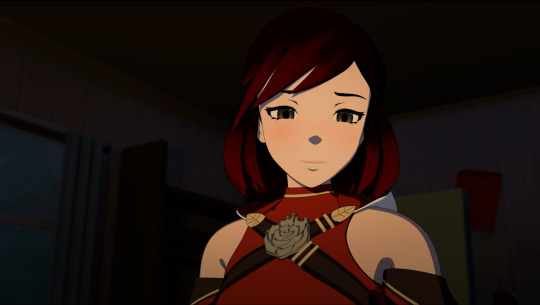
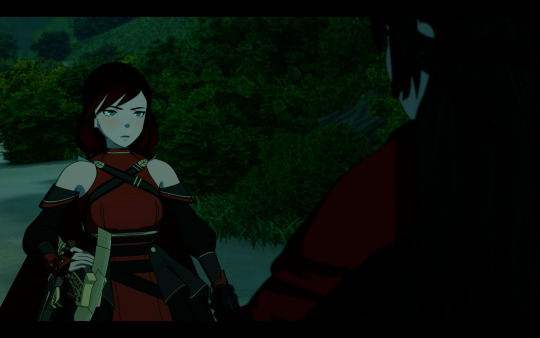
Just compare Summer’s scene with Tai to both her previous scene with the sleeping Ruby and Yang, and her following scene with Raven; both showing Summer not putting on any kind of act for anyone else.
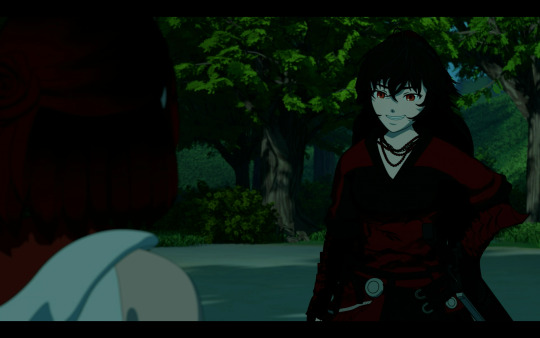
Most notably, despite whatever resentment she might feel towards Raven for leaving them (or perhaps just leaving her), Summer clearly trusts Raven, more than ANYONE, with helping her on this mission she considered so vitally important.
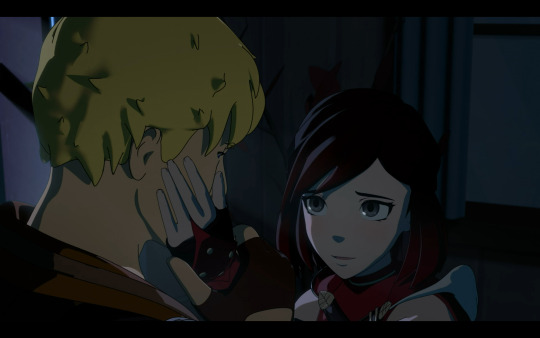
Summer certainly cared for Taiyang, that much is clear. Otherwise she wouldn’t put so much effort into reassuring him that everything was fine.
But did she love Tai in way that he loved her? Or was it simply a role she went along with for his, and possibly more-so Ruby’s and Yang’s benefit? Given the clear emotional mask and barrier we see her put up when around Tai, I would call the answer, at BEST, ambiguous.
Which all ties perfectly into what we see in The Warrior in the Woods.
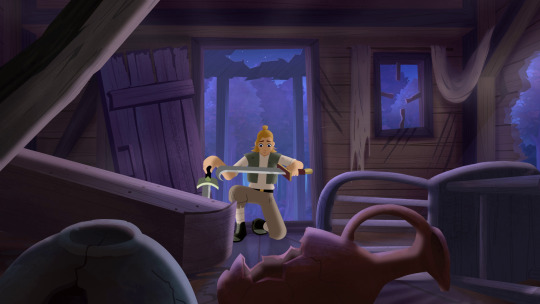
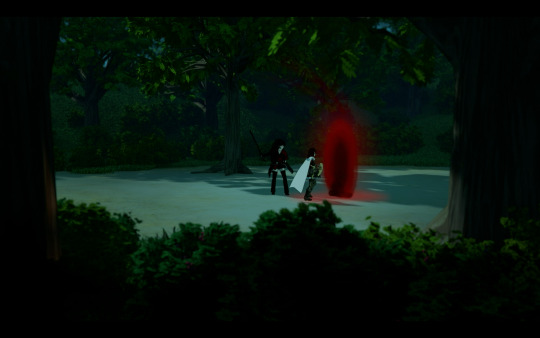
The boy in the story, who is presented as looking just like Tai, loved a mysterious but noble warrior, who is presented as looking like Raven AND Summer. But the love the boy felt could not or was not returned and the warrior would instead vanish into the night. Just like Summer and Raven did.
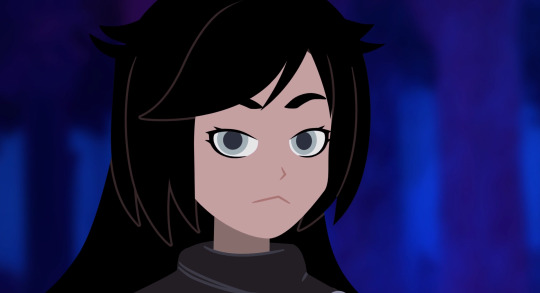

Oh, and the ending of the story match-cutting a shot of the ‘cross between Summer and Raven’ Warrior to a shot of Ruby who likewise has a lot of visual similarities to Raven as well as Summer MIGHT be hinting at something too…
#rwby#rwby analysis#rwby theory#rwby fairy tales of remnant#rwby the warrior in the woods#Summer Rose#Raven Branwen#taiyang xiao long#Ruby Rose#narrative parallels#i think not enough people appreciate just how LITTLE we actually KNOW about ruby's and yang's parents#rosebird parents theory#yeah i couldn't resist slipping in a bit of rosebird parents theorizing XD
101 notes
·
View notes
Text
I took a creative writing class for my degree and the professor had us post all our work under pseudonyms so none of us knew who was writing what. We’d read all the pieces and discuss them together as a class. I ended up befriending a trans girl and a younger guy and as it was an online course we’d chat on a side channel together.
On the last day the professor had a game where we tried to guess who was who. In the side chat my friends were saying they had no idea who’s was who. I was like, “Well, I expect X is Younger Guy, as these stories were all highly referential to games and race cars and you said you collect hot wheels.” He laughed and said yes, I’d got him.
The trans girl says, “Any idea which one is me?”
And I was like, “Hm… oh! I think you’re probably Y because every story you turned in had a deep fascination with transformative states and what femininity and personhood mean to the protagonists, as well as a strong emphasis on self discovery.”
After a moment she was like “Damn you didn’t have to come for me that hard!”
#funny#story#art school#creative writing#mine were all set up like fairy tales that subverted gender norms and she got me back with that analysis#ramblies
1K notes
·
View notes
Text
Inuyasha & Demisexuality
i think halfway into writing this i thought about just cramming all my thoughts into a semi-coherent rant due to a combination of a.) lack of access to decent translations of the manga and b.) paranoia about over-analyzing scenes and coming off as delusional (i think by now it's probably too late to thwart that claim) buuut this headcanon in particular is near and dear to me so i want to try and get as in depth as possible.
what is demisexuality?
in simple terms, demisexuality is when an individual doesn't experience primary attraction - that is, the sort of attraction based on immediate observable (often physical) characteristics - and instead only experiences secondary attraction first: the type of attraction that forms after the development of a deep emotional bond.
inuyasha and kikyo
this aforementioned term perfectly describes inuyasha and his relationships with the only women he's ever loved romantically. you could make the claim that his inability to feel primary attraction first stems from his trust issues and not inherent sexual orientation. and to that, i would disagree - he and kikyo develop an emotional bond despite an unspoken lack of trust, which may have improved had naraku not meddled in their lives. still, both find solace in each other's similarities, loneliness, and "outlier" status (though the similarities are in isolation only, if i'm being completely honest) and establish a connection that persists post-revival.
inuyasha eventually did start to feel primary attraction to kikyo during their time together - in the second chapter of the manga, when he compares kagome to her, he states that kikyo "looked pretty."

[source - viz. i haven't been in this fandom long, but what i've gathered is that there are a lot of mis-translations of this manga, even from viz. since i have yet to buy physical copies of the manga and don't have an account for the site, i'm going to be using fan-scans for the rest of these, which hopefully won't really affect what i'm trying to convey since i'll be looking at character expressions rather than dialogue for most of them.]
i'd also note the order in which he lists those traits: kikyo looked intelligent and pretty. her intelligent appearance is the first part of her he remembers, which i think underscores his priorities in this regard. he values things like intelligence and companionship - facets that come to light when developing secondary attraction towards someone - more than aspects of primary attraction.
inuyasha and kagome
as mentioned before, demisexuals don't feel physical attraction before establishing a tight emotional bond. the most blatant examples i could think of this were any instances in which inuyasha sees kagome nude and his difference in reaction - in particular, during the yura of the hair and togenkyo arcs, which are roughly seventy-three chapters apart. there are two new moons in that time, and from that we can say at least two months have passed.
chapter six: yura of the hair
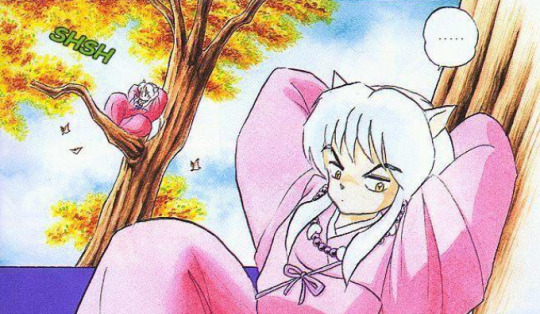
kagome's bathing below him, and i'm sorry, but this expression literally screams "zero fucks given." he does not care in the slightest. not a blush. not a spot of red on his cheeks. not a sweatdrop. not a tee-hee. if i were to describe what he's feeling in this moment i would say "extreme ire." when she uses the sit command on him, it's on the assumption that he's "peeking," but kaede understands that it's actually because inuyasha is trying to steal a shard of the shikon jewel.

"huh?" - he sounds genuinely confused that she reached that conclusion, even though he was quite literally peering over the cliff's edge in what obviously has very perverse connotations. it's almost like he doesn't understand why kagome would think his actions come from a place of sexual attraction because that sort of thing just isn't on his mind at all, and he doesn't get why it would be in the first place.
another extremely blatant example can be see in miroku's introductory chapter: chapter 51, the delinquent priest:

do i even have to say anything. this scene also further emphasizes my previous point - before, the only reason he was there was to try and steal kagome's jewel shard. if his true intentions had been driven by primary attraction, this would have been an opportune moment to "peep." in his words, however, he just isn't interested. note that he could have said something along the lines of "i wouldn't do something like that" (which, if he was attracted to her in that way from the start, wouldn't have done anyway) but specifically i'm not interested. the primary attraction is not there in the slightest. at least, not until:
chapter eighty two: fateful night in togenkyo
the scene i'm talking about needs no introduction, but for context: kagome's half-freaking out after having woken up in a sake bath. inuyasha breaks down the door to come and rescue her, accidentally seeing her naked in the process. well, i'm sure his reaction won't be that dif-
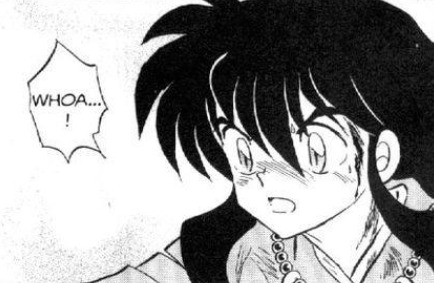
...it's only one panel-
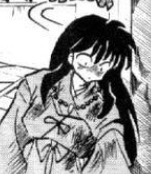
okay, two-
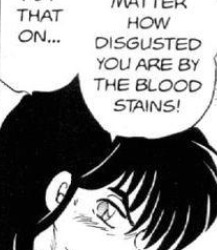
i think at this point it's fairly obvious that primary attraction has developed. besides the fact that he's spent three panels trying not to look like he's having a quasi allergic reaction, it's been approximately two months since they've met, and by now they've definitely formed the deep emotional bond required for him to begin feeling any primary attraction at all. in fact, the chapter where he tells kagome "there's no replacement for you" - that chapter, where he's vulnerable and honest and opening up to her, strengthening their bond further, (ch. 78, a tender smell) is directly before the togenkyo arc begins, and, thus, just before these scenes occur. these chapters have all been building up secondary attraction, and now that primary attraction is just starting to show up.
several chapters later we have this iconic panel from 173:
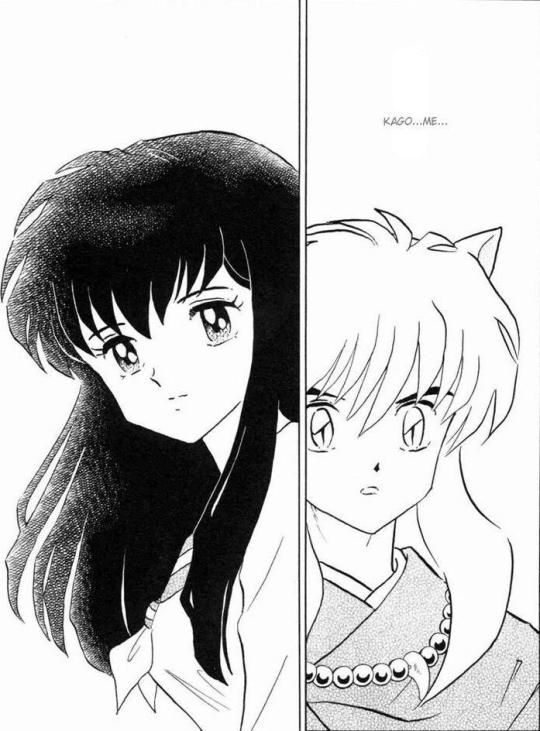
this is such a look of awe, as though he's gazing up at a goddess. jaw dropped, eyes-wide, words trailing off awe. he's entranced. fully head-over-heels in love, feeling both primary and secondary attraction in regards to kagome, and this trend only continues throughout the entirety of the manga.
conclusion + extra thoughts
my belief in this headcanon comes from not just the evidence depicted above, but because i just related a ton reading those scenes. i found myself just nodding along (as someone who's demisexual themselves!) plus, since ace-spectrum representation is so rare, it's nice to see it reflected in a character whose story and relationships i love dearly.
tags: @nightshade-lullaby
#sorry this is formatted badly lmao#anyway we should totally make this a fandom consensus guys trust me#i realize i could have done this during inuvember's pride day#but i STILL haven't finished reading the manga (excuse: university) and wanted to give this post the more detailed explanations it deserve#honestly i'm ass at analysis but i hope this makes some sense#inuyasha#inumeta#inuyasha headcanons#inukag#inukik#i suppose#kagome higurashi#inuyasha x kagome#inuyasha a feudal fairy tale#inuyasha anime#inuyasha manga#demisexual#ace spectrum#next analysis: me crying about the jineji chapters and its impact on inukag#u dont understand how FERAL those chapters make me
175 notes
·
View notes
Text
Bucchigiri Utena Parallel-Wannabe Heroes and the Illusion of Fairy Tales
Apart from the NNL segments, I've also had some thoughts on the Bucchigiri storyline and it's parallels to the themes of Revolutionary Girl Utena. And this time my focus as been on Matakara, who has often been hailed as being the true protagonist and hero of the story because of his honorable, kind-hearted and proactive qualities. Much like Utena herself.


And like Utena, the two share a somber backstory where they held on to fairy tale beliefs to help them overcome their hardships and grow into the heroic figures they wish to be. But what they don't know is that they naively followed these tales without realizing the misinterpretations of those beliefs that have been passed down for generations and would soon become victims of the fairy tale figures that once inspired them.
But before I can delve into that story, we need to talk about this story.
Note: This post will contain MAJOR SPOILERS from the Revolutionary Girl Utena anime. If you still haven't watched it and want to be unspoiled, then please refrain from reading this until you've seen it. If that doesn't bother you, then go on ahead. Also, I would strongly recommend speaking with a friend or a reliable user about the dark and trigger-worthy content featured in Utena before watching. It's a great show but it does get DARK.
Also, there's another user who's planning on making an analysis post comparing Matakara and Anthy Himemiya so keep an eye out for that if you're interested in more Bucchigiri-Utena parallels.
Part 1: Origins of an Orphan
To start, Matakara's backstory and his idolization of Arajin has multiple similarities to Utena's backstory. For the purpose of this section, I'll be using the version that was shown to us in Episode 1 and not the true version.
"Once upon a time, many years ago, there was a little princess and she was very sad. For her mother and father have died."
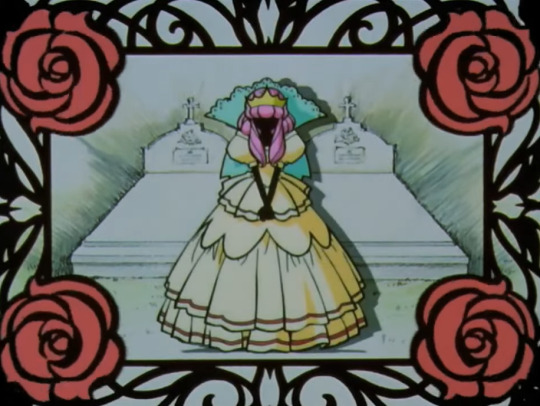
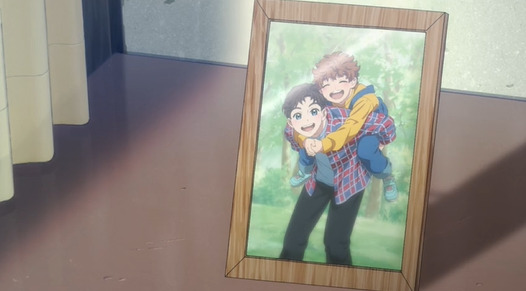
The first piece of info that Utena gives us is that she was an orphan and was in despair because of her parents' deaths. Though Matakara's own parents haven't been brought up nor has it been explained what became of them, it's clear that he lost them at an early age. And while he did have his older brother and his presumed relatives to watch over him, this did very little in helping Matakara overcome his grief or escape the shadows that haunted him since he was little.
"Before the princess appeared a traveling prince riding upon a white horse. He had a regal bearing and a kind smile. The prince wrapped the princess in a rose-scented embrace and gently wiped the tears from her eyes."

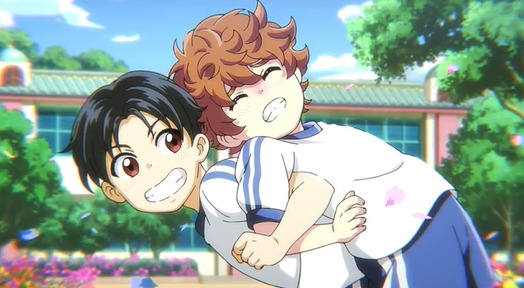
While lacking the regal bearing and white horse, Arajin was the traveling prince who came into Matakara's life and inspired hope and light within him. As shown in their flashbacks, he was always a friendly and cheerful boy who radiated confidence and spirit. A true hero that Matakara could look up to and help him overcome his sorrow.
"Little one, he said, growing up alone in such deep sorrow, never lose that strength and nobility. Even when you are a young lady. I give you this to remember this day, we will meet again. This ring will lead you to me one day."
The crux of Matakara and Arajin's friendship was their desire to train and grow into becoming true Honki people. Warriors with strong hearts and did not flee from battle. Arajin genuinely saw that Matakara had that potential and encouraged him to train alongside him.
And what's more noteworthy is that the two are given a token to immortalize the moment. Utena is given a rose ring to remember the prince and her own nobility while Matakara is given a friendship stone to remember their bond as future Honki People. Even as their fated princes leave, the two heroes carry those precious tokens well into their adolescence years, never forgetting their mission of becoming the people they want to be.


It could also be argued that Mitsukuni, his older brother, could qualify as the prince in this scenario as he inspired him to stay strong in the face of adversity. Such as in Episode 8 where he explained the creed of the Honki and how he inspired his little brother to be brave like them. He even brings up their creed to Matakara just before he's hauled away to the big house.

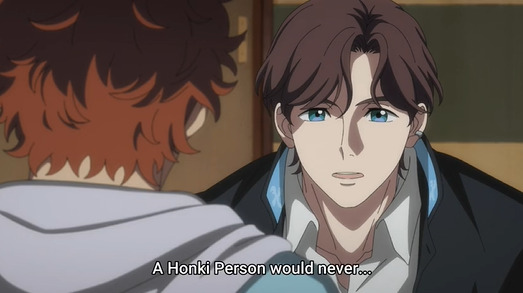
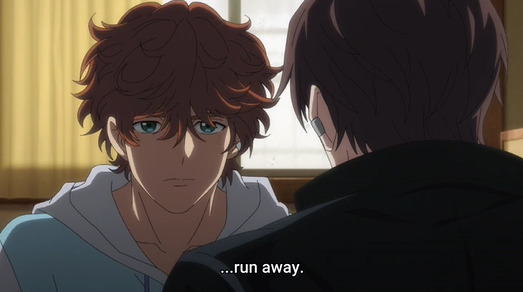
"Perhaps the ring the prince gave her was an engagement ring. This was all well and good but so impressed was she by him that that the princess vowed to become a prince herself one day."
So the cherished prince rides off into the world leaving Utena alone, much like Arajin and even Mitsukuni would leave Matakara alone because of their respective issues. But rather then succumbing to despair, the two heroes resolved to maintain the noble spirit that those heroic figures saw in them. Utena went on to become a prince herself while Matakara would become someone worthy of being a Honki person. Though Matakara struggled more on his journey given how he threw himself into bloody battles while being alone, he would eventually be adopted into the Minato Kai Gang and become closer on his path to becoming a Honki person.
And just before we can go straight to Utena's story in the present, the fairy tale closes with a question to the viewer.
"But was that really such a good idea?"
For first time viewers, it's easy to interpret this question about Utena, a girl, becoming a prince since it defies traditional gender roles and what is expected in classic fairy tales. But as the RGU story progresses, we see that the concern comes not from a girl becoming a prince but more on the problems that come with being one.
Two in particular stand out. The first is that men who become princes usually use those roles for the sake of superiority and having control over women. They lack the nobility a true prince should have and relish in the title because of it's power and privileges. The second problem, and the one that this analysis post will focus on, is how princes who live up to those roles are exploited by the people they try to protect.
Part 2: The Truth That is Twisted by Time
All fairy tales, legends, myths and stories which have been passed from one generation to the next. And as the years go by, those stories are often subject to adaptations based on the preferences of the storyteller or how society uses those tales to explain their respective beliefs. A common criticism is how most fairy tales have more imaginative elements in play and avoid the grittier elements that the tale originally used (Ex. Cinderella got her dresses from a tree instead of a fairy godmother and her stepsisters chopped off parts of their feet to get the slipper to fit, Aladdin used African slaves as part of his prince con).
And we see those changes in adaptations in the fairy tales Utena showcased that omit or warp the truth to the ones who hear of them.
Such as in Utena's origins, we're told that it was only a prince who inspired her to become one so she can reunite with him one day. But the truth was that her decision was because she met Anthy who was suffering from the hatred of humanity. And the only way to rescue her was to turn into a prince whom she could believe in.
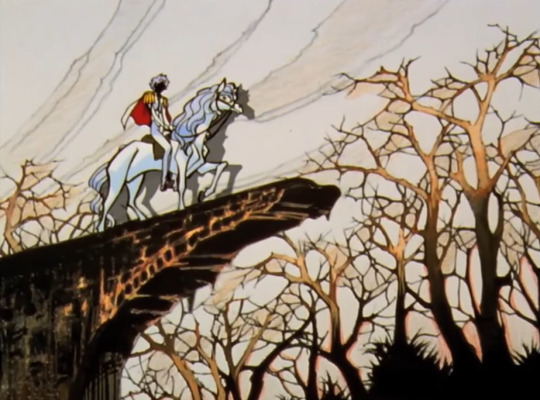



We also see a new adaptation in the backstory of Anthy and Akio which is now known to the world as The Tale of the Rose. The world remembers their story involving a powerful and perfect prince who was stolen from them by his sister who turned into a wicked witch out of jealousy. But the truth was that Anthy sealed him away not out of spite but out of love and concern as her brother was being exploited and over exhausted by a massive, unsatisfied world who overly-depended on him.




So as Utena demonstrates, the fairy tales we start out learning about aren't exactly as true as their origins demonstrate. They often omit or do away with the more tragic and gray aspects of the characters in those stories. This is all well and good, but what does that say about the Honki People?

Right in Episode 1, we're told that they're courageous and valiant fighters who train nonstop and pour their heart and soul into battle. Despite being brushed off as a simple old story in the present day, their legends and battles prove worthy enough of recognition. They have a temple in their honor, Arajin and Mataraka trained to become like them, and even the city is named after them. The narrative does a decent job in explaining the concept of the Honki People, but what about the people that inspired those legends?
As we see in Episode 9, we learn that Senya and Ichiya actually started out as ordinary humans who dedicated their lives to training and fighting one another, hoping to become a true Honki Person. It's stated that Ichiya was training himself to be a Honki Person so the legend was already around when the two of them were only boys growing up in a Middle Eastern town. And fitting the Aladdin parallels, Senya started out as a simple street rat with no family or home to call his own. And after meeting someone as cool, powerful and inspiring as Ichiya, he decided to spend his life alongside someone he could call his friend.

A rather somber element is that while the whole world grew up learning and embracing the Legend of the Honki, none of them actually knew who those Honki People were or what their past lives were like. Would it even matter to them how they started as humble street urchins with no family or home to call their own? They knew what they turned into, but they never stop to think about who these legends started out as or what their backstories or even their names are.
But what's more tragic is what became of Ichiya, the one who inspired Senya. Though we still don't know the exact details for what Senya did that tarnished their friendship, it ultimately impacted his best friend for the worst, corrupting his heart and letting him be filled with hatred and contempt. He no longer valued friendship like he did when he was human and views it as a weakness that must be purged. Perhaps becoming a true Honki Person wasn't all it's cracked up to be given how they're bound to pistols and made to serve whoever finds him for thousands of years.
It's akin to the Rose Prince who's powers were sealed away by Anthy in a desperate act of love leaving him unable to save the world like he used to. Only because of his powerless state did the Prince lose his heart and became a cruel, manipulative and spiteful monster who longed to reclaim what once belonged to him. He would even resort to inflicting every form of abuse imaginable onto his sister as "punishment" for what she did to him. (And yes I do mean every form so please keep that in mind if you haven't seen Utena yet!)
The hero who was glorified and admired in their respective tales loses their nobility in real life, allowing themselves to be corrupted and be filled with new desires of revenge and power. Transforming into the opposite of what they represented in the generations that told their stories. Simply put, they become a villain.
A villain who is...
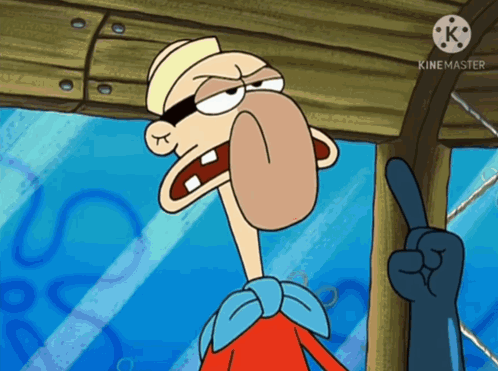
Part 3: The Virtuous Victim Turned Vile Villain
Bucchigiri and Revolutionary Girl Utena are shows that share the themes of fairy tales while deconstructing and subverting tropes associated with them. One of which that the two share is playing on the idea of a heroic or fairy tale archetype (the genie and the prince) becoming the villain of their respective shows. It's even more ironic that the true heroes of those series would start out being inspired by adaptations of them that portrayed them in a positive light only for to fall prey to their schemes when they meet them in real life. Bucchigiri has Ichiya, a true Honki Person that Matakara heavily looked up to, and Utena has Akio, the Fallen Prince Dios who led the sad princess on the path to becoming a noble prince.

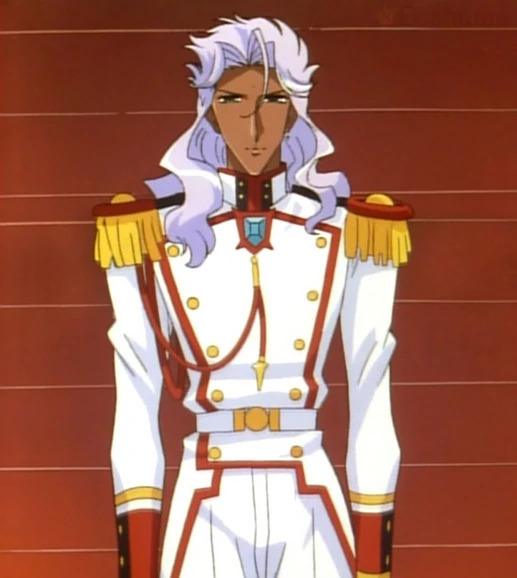
Each of them started out as the ideal fairy tale figure that helped the heroes when they were only children who confronted sadness and loneliness at a young age. But now that they're older and are meeting with them, they end up falling victims to the fairy tales they initially admired and tried to become. And neither of them realize that they're being used as it happens.
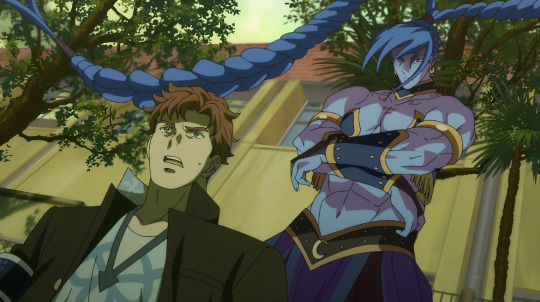
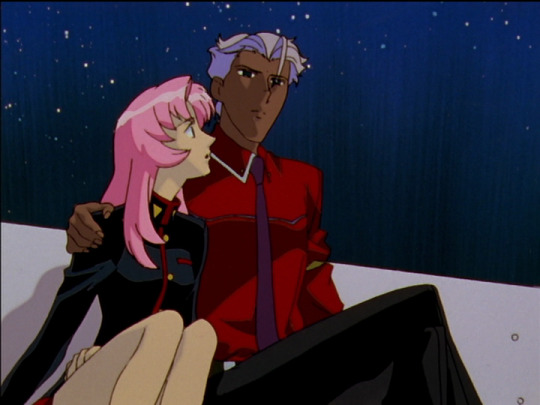
Ichiya's goal is ultimately to merge with Matakara to take over his body and exact his revenge on Senya. As to what Ichiya's motives are after taking his revenge aren't clear, but what is clear is that Matakara will lose himself after being completely possessed. And because Matakara is suffering through his feelings of loneliness and his childhood friend's true nature, he doesn't even notice how Ichiya is manipulating him to improve the merge rate.
Akio's goal has been to groom Utena into producing a noble heart that can help him reclaim his original powers, even leading her in an intimate relationship to further manipulate her. Should he succeed, then he'll discard Utena and move with his life as Prince Dios once again. If not, then he'll discard her and find another person to groom. And Utena doesn't realize this as she's led to believe that he's the prince who once saved her from despair and she'll get the happily ever after she believed will make her content.
The scary part about this, is that they're not the first victims to fall prey to their wicked schemes.
Though it hasn't been confirmed on Ichiya's side, it's heavily implied that he's bonded with other people who found his magic pistol before taking full possession of them. Given how he's lived for thousands of years and initially resided in a public Honki temple, there's no way he would have not been found by some unlucky sap. His common knowledge of possession would suggest he's done this before and has seen the unfortunate results of the person he takes control of, which he mentions to Akutaro.
As for Akio, he also has lived for thousands of years and organized constant Rose Duels in the vain hope of choosing one lucky winner to steal their heart so he can break. Using his sister as a prize to be one, there have been countless tournaments held with the hopes of finding the right target that can help him regain his powers from the Rose Gate.
Alas, neither villain was successful with their attempts given that they've turned their sights on the new generation of heroes to continue their cursed wishes that have lasted for centuries.
And speaking of wishes, remember how I brought up in Part 2 how fairy tales were much darker compared to the more enchanting stories we grew up with?
Well thanks to a peculiar finding by @mahoromouse, I came to realize something about Ichiya and possibly Honki people in general. They're not even genies, they're djinn.
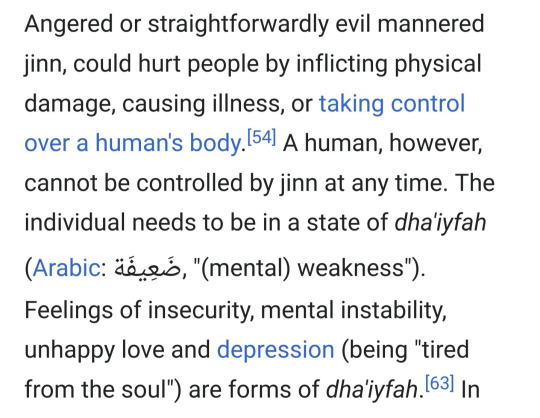
Contrary to the Western media's adaptation of genies as whimsical, playful, wish granting spirits who are voiced by beloved comedians, djinn were actually neutral spirits who were born from fire and were able to wander the Earth like humans do. That said, there are some djinn who grow stronger when interacting with negative emotions found in a human being. It's even said that they can inspire greater levels of negative emotions in a human that they target. Much like how Ichiya is cultivating Mataraka's anger towards Arajin and his fears of the shadows that haunt him.
And how fitting it is that from the moment Senya was introduced to us, Arajin and the audience interpreted him as a genie. Especially given that Senya even offers him a wish while proclaiming that "Honki" can also be spelled to make "Majin" 魔ま人 which in Japanese means "demon person" or "magical person". But have we actually seen Senya grant Arajin's wish of losing his virginity? While he does help the boy in getting stronger and boosting his image as a man, that doesn't mean it's gotten him very close to losing his virginity (thank goodness). And it can be inferred that Ichiya never granted Akutaro's wish despite having stayed by his side during his reign as the NG Emperor.
Given how the Western's portrayal of genies have been popularized and glamorized for years, we have easily forgotten the true origins of genies or djinn and the grittier aspects associated with their backstories.
Conclusions
The theme that the two shows share is how a child who was in a dark moment in their life was inspired by a fairy tale to help them find the light. And so touched were they by the heroes in the stories that they decided to become just like them. But as their respective shows demonstrated, that wasn't a very good idea. The Prince and the Honki Person they once admired turned out to be monsters who resolved to exploit them and reclaim something that was lost to them many years ago. And because they grew up with the romanticized and ideal versions of their idols, they never realized the truth about them which was lost in time mixed with ongoing adaptations that omitted their pasts making them more acceptable to the world.
As for whether Matakara will be saved from Ichiya's corruption while still gaining a heart that does not flee, I cannot say. But as it stands, it looks like Arajin will need to be the one to come in and save the boy he once inspired and who still holds dearly in his heart. And just like I mentioned in my last NNL segment, maybe their friendship won't be the same anymore despite defeating Ichiya. Maybe Matakara will still harbor negative feelings to his friend for how he was mistreated and abandoned for so many years. But much like how Utena ended on a hopeful ending, I believe the same thing can happen in Bucchigiri.
And those are my thoughts on the matter. It's been a great while since I wrote an analysis post this big so thank you if you committed to reading all of this. So what do you think of these themes? If you agree or disagree with anything I've written, please feel free to reblog and/or comment with your own ideas. Thank you and may you have a great day/night!
#bucchigiri#bucchigiri?!#revolutionary girl utena#rgu spoilers#matakara asamine#utena tenjou#arajin tomoshibi#mitsukuni asamine#ichiya#senya#akio ohtori#anthy himemiya#fairy tales#analysis#eddy's post#loving these parallels#anime#long post
73 notes
·
View notes
Text
When I watched "Nimona" for the first time, I was struck by the fact that the villain of the story, The Director, doesn't have a name. Throughout the movie, she's simply referred as The Director. And then it hit me. Nimona is a deconstruction of the typical archetypes you meet in fairy tales. In most fairy tales, the hero has to fight an evil monster, like a dragon that guards a treasure, or an ogre and a giant that likes to terrorize people or a wizard or a witch that has cursed a noble princess. Most of the times, these monsters don't have a name. The dragon in St.George's story doesn't have a name. The giant in Jack's story doesn't have a name. Neither Snow White's stepmother, who is simply referred as The Evil Queen. By leaving The Director nameless, they put her in the same position as these monsters.
#nimona#nimona netflix#nimona movie#the director#analysis#nimona the director#nimona the movie#nimona 2023#the director nimona#fairy tales
294 notes
·
View notes
Text
Being the angst sucker that I am (but also a coward that doesn’t want to feel too depressed about bad endings), I headcanon a lot about the dynamics and end/post game canons for Astarion and Karlach as a couple (no shit!).
I know a lot of people ship Karlach with Dammon. I obviously don’t, but not because I think they don’t fit well together or whatever. I have this thing in my head of how I view Karlach which puts her relationship with Astarion as more realistic, more fulfilling, and more attractive to me (duh).
Dammon as a character is a nice, hard working guy. He’s also crazy handsome, has the hots for Karlach and some mechanics knowledge to be able to help her a bit. So yea, cool. I like him a lot so that’s not it.
BUT.
Just gonna blurt it out: I think Karlach is too fucked up to be with him in the canon universe we have. It’s a similar reason I have for how I see her reaction to the love test in the Circus in Act 3, which I made a post about. Had Karlach never been betrayed by Gortash, had not been irreversibly damaged (in more ways than one) and not been transformed by her 10 years ordeal, Dammon would be the ‘perfect pairing’ for her - a gentle, good hearted, generous and hot piece of ass. Thumbs up.
HOWEVER.
She’s not that girl anymore. She keeps it bottled up, pushes it down and shuts herself to what her trauma did to her and while it’s commendable, imo, it’s not real. She wants it to be so bad because she’s got so little time and is desperately clinging to her life before she started making mistakes (now being back in the Material Plane after so long). If she doesn’t die, though, she won’t keep this up forever. She’s carrying pain, remorse, ANGER, jealousy, self pity. A LOT of it. Much more than she let out in her post-Gortash breakdown. All these are very human emotions, and very understandable in her situation. She also changed, physically, mentally, emotionally. She grew, she learned- and it wasn’t all pretty and nice things. I like the idea that she’s being the most genuine character in the game while ALSO being the one wearing the most impenetrable mask. It’s wild and damn cool to see her through that lens.
Which brings me to Astarion.
He is also wearing a mask, but a much more frail one. He’s cracked. He tells and shows us these ugly emotions, his selfishness and hurt, much more directly than Karlach does. He’s broken, wicked, mean. It’s clear his trauma completely changed him (though I don’t think he was a good guy before it either), and is entrenched into who he is when we meet him - and will continue to be part of him even after he heals.
I think Karlach is attracted to him not in spite of how mean he is - but because of it. I don’t think she’s aware of it, though. She says something about Astarion having a good heart beneath it all - and while he might have something like a better heart inside that can be rescued, he’s not inherently good, nor he was before being turned (nor he wants to be). The dynamic of Karlach using goodness and positivity as a lifeline, as if to counter the decade of (literally) pure evil she’s been forced to endure, while also ‘surprisingly’ getting along so well with Astarion from the start, also being attracted to his wickedness, gives an incredible depth to their relationship. I see not only the idea of Karlach’s kindness, non-judgement and patience being a refuge for Astarion, but Astarion’s grey personality being a refuge where Karlach will be able to let her walls down - show the ugliness bottled up inside - without fear or shame, and knowing it will be completely and utterly understood. Astarion will never judge her for whatever impulses or thoughts she might have, for displays of selfishness, jealousy or violence. Imo, they can even work some of those out together (wink wink, but not only in that way lol). At the same time, I do believe Astarion saw from the first glance he had at Karlach (or in the first couple of days) that she carried a pain much like his. It’s why he respects her, why he is so quick to apologize to her and only to her, why he feels empathy for her suffering while being absolutely cold to the others. She’s the first one who gives him the opportunity of allowing himself to feel safe, to let his guard down if only for a night. His connection with her might be based on a selfish start (it’s about him - she is like him), but it grows to be more complex as they grow closer. I see him slowly falling in love with her as a parallel to him slowly learning to love himself, to forgive himself.
It’s all so beautiful, poetic and layered and shit (wow, me so eloquent).
But in all honesty, that’s all to say, while I think Karlach and Dammon look nice together, I see him as being the person who’d have been the one for her if she was just Karlach Cliffgate. However, she is not. She is Karlach Cliffgate and she is also Karlach Demonsbane - and for that ‘her’, Astarion - with his imperfections, his wicked ways and his darkness - is the one who truly fits her perfectly (or imperfectly, which imo is even better).
Thank you for reading all this rambling. I love rambling and will (can) never stop so good for you :V
AGH I LOVE bittersweet gritty messy romanceeeeeeee (but I wanna give them a better ending than the one in game - though if the patches weren’t broken, it’s improved a bit already)
#bg3#baldur's gate 3#bg3 ramblings#bg3 character analysis#bg3 ship analysis#(is that a thing)#astarion x karlach#karlach x astarion#karlach#astarion#hellspawn#starlach#fireblood#why I love this ship so much#you can go so deep#and it’s not a fairy tale bs#it feels real#YUM
49 notes
·
View notes
Text
Equality and the School Master Brothers
Remember how the Storian insists on the brothers being equal in all things? On a literal level? That’s so contrived. That’s how you treat small children, not respected, public figures you expect mature behavior from!
And if that element were removed—well actually, maybe it couldn’t be, as removing it would reduce the intensity of the Equal Treatment/Chances fairy-tale element, of the satisfying (to whom? Us? The Pen?) repetition and symmetry, reduce the mystique itself around the ways of their world. Yet still, that form of balance is wrong.
I mean, it’s like how they each were expected to each have their own Reader to return with, in order to leave Gavaldon, be permitted through the barrier. The artificially enforced equality in all endeavors kills the need to think, two and two, one and one, etc., and then, there’s: what if this balance issue were addressed in a non-literal, utterly equal sense? You can’t make two humans with separate identities 100% equal.
Why couldn’t the trade-off have simply been something like: have any means or inequalities you want along the way, to achieve a more figurative, abstract, big-picture form of equality after events have come to pass naturally? It'd still be equality in a sense. Like, the same number of Good endings and Evil endings to tales, for instance? That, instead of micromanaging things on such a small scale.
Besides, the brothers aren't the only control freaks. The Pen is just as much a control freak and Rule follower as Rise Rhian and Fall Rafal are, despite having set the Rules by itself. (But, does it only follow its own established Rules when it's convenient?)
The Pen has such a low threshold for minute things being off, for misalignment. (Probably because it's the details that make a story worth telling.) Like: oh, that brother cheated? Let’s wait—for the other one to cheat, too, before we let anything else change. No preventative measures. Nothing, nil.
Things are stagnant until both brothers comply with or rather, fall into, the equality trap. A trap which probably makes them less equal in some contradictory fashion!
Dealing with that high level of scrutiny, all to live under the tyranny of Pen? It must be suffocating. And they had different needs. So, they didn’t need the same treatment all the time. They could’ve benefited from inequality as long as they were both served according to who they were.
How flagrantly wrong everything in the duology went plot-wise is at the very least evidence for how not every quality can be saved by or reduced to numbers and systemized for the world's convenience. And, as a storyteller, the Storian probably should've known this, to let faces be faces, instead of more statistics piling up. Though, I'm sure its reasons for withholding "character" names were more to generate further drama and suspense or to implant ideas in people's heads, not weak writing.
#school for good and evil#rise of the school for good and evil#rafal#rafal mistral#rhian#rhian mistral#the storian#storian#sge#sfgae#the school for good and evil#tsfgae#rotsge#rotsfgae#my post#my analysis#the balance#balance#equality#symmetry#theme#thematic idea#classic fairy tales#fairy-tale convention
20 notes
·
View notes
Text
"Amy's just an obsessive fangirl," then explain her reaction to Sonic in Unleashed? Most fans and paparazzi and whatnot ditch their favorite for a new favorite the second their favorite turns weird or ugly. But Amy still loves werehog Sonic as much as daytime Sonic. Once she understands, she's like, "Oh, this is who you are now. Cool. I hope you're all right. Now when can we have a date?"
Granted, she doesn't necessarily have her priorities in order there, but she still cares about him. She just got confused when she first saw him. I saw a translation of her Japanese dialogue one time, and she said something like, "But I know I felt Sonic's presence." As soon as Amy finds out it really is Sonic, she's by his side again. As far as any of them knows, Sonic could be like this the rest of his life, and she doesn't care, as long as she can be with him.
#sonic the hedgehog#amy rose#sonamy#sonic unleashed#werehog#my analysis#do... do y'all just hate sonamy because you just can't understand or appreciate an expression of pure love?#is the world so messed up that you just can't believe that real love only exists in fairy tales?#a love that looks past the surface and into the heart?#if so then i feel very sad for you#not sorry just sad#i hope you do experience that kind of love someday#i have#and it's honestly life-changing
118 notes
·
View notes
Text
Presenting the results of my latest hyperfixation
Tam Lin is a Scottish folktale, usually presented in ballad form, dating back to at least the 16th Century. It has been summarized and re-told by different people over the years, including Overly Sarcastic Productions. It is the subject of a one-act opera, and was the inspiration for a 1970 movie that updated the story to the present day.

The fairy queen yells at Tam Lin in every version analyzed except for the Anais Mitchell version. Her version is an outlier in many respects, since the entire parade is left out, Janet simply grabs hold of Tam Lin mid-conversation.
Another oddity is Pentangle's version, which was written for the movie and consists of a jumble of images meant to complement scenes from the film, without a coherent narrative.
The biggest surprise to me is how few versions mention Janet seeking an abortion, something that I had always thought of as a central part of the story.
One thing I wish I could have looked at in more depth is the balance between versions that describe Tam Lin's transformations before he goes through them, and versions that describe them as they happen. As they happen is more common, but some songs will do the entire sequence twice.


Going into this, I had two versions prominent in my mind: Anais Mitchell's pop-folk version that leaves out much of the story, and Anne Briggs' very traditional (and very long) version. Because of this, I thought perhaps we would see a decrease in the complexity of the story over the years, but that's not the case, it's basically flat. I think a better comparison might be to separate into traditional and revised versions, although that is something of a judgment call.

There were so many minor discrepancies I couldn't even keep track of them all, but these four stood out because they are so oddly specific. Even the main character's name and the setting aren't consistent across versions, if they're even mentioned at all. Some versions don't even give the main character a name!
My data collection process leaves a lot to be desired, as well as the way in which I decided which events were major or minor, and which things to leave out altogether. This was mainly just a fun way to explore different versions of my favorite folktale, listen to a lot of different people sing different versions of the ballad, and rotate the whole thing in my brain.
31 notes
·
View notes
Text
The Snow Queen: Story the Fourth: The Prince and Princess
This section is one of my favorites.
Having escaped the enchantress, Gerda comes across a crow. She asks him if he’s seen Kai, and he says he might have.
The crow describes the princess of this land, and exceedingly clever young woman who’s read every newspaper ever written. The princess wished to marry, someone both handsome and clever, and many suitors came. On the first two days, all the suitors were too star struck to say anything to impress the princess. But on the third day, a young man came who was handsome and clever and charming, and he won her heart and her hand.
This, the crow thinks, may be Kai, and Gerda agrees, for he is handsome and clever, with bright eyes and long hair, poor clothing, and new boots that creak, and he arrived at the palace carrying something on his back, which may have been a knapsack, but may also have been a sled, for the crow did not get a good view.
The crow takes Gerda to the palace, where she is introduced to his crow girlfriend, who lives inside. They take her up a back stairway to the princess’ bedroom, where she and the new prince are sleeping, in two separate beds. Gerda holds up a lamp to the prince, who wakes, and turns, and is not Kai.
The princess wakes as well, and Gerda and the crows explain the whole story. The crows are given a position in the court as a reward for helping Gerda, but warned not to sneak anyone else into the royal bedroom in the middle of the night. Gerda is given the prince’s bed to sleep in, and the next morning, a new pair of boots, a muff, and a coach and escort to continue her search for Kai.
There’s just a lot going on in this section. I love the story of the prince and princess, and the little detail that she’s read every newspaper ever written, which I leaned into heavily for my interpretation of the character. I love the detail of dreams following people through the palace, and the revelation that Gerda’s grandmother can speak crow. I love that we acknowledge how lonely Gerda is, how hard this journey is. And I love that this is the first section where we really see other characters being kind to her, and helpful. I love her faith in Kai, her confidence that he’s worthy of marrying a princess, and that he’ll welcome her with open arms, even though he hasn’t exactly been nice lately. It’s just a good section.
5 notes
·
View notes
Note
A little late, but reading your take on Enchanted made me remember how much I love that movie. What are your thoughts on the rest of it? Like say, what do the Prince and Nancy represent? What about the villains? I’m curious how they fit into the allegory
Prince Edward is just like Giselle in the sense that he does what people accuse Disney Princes of doing, and it's funny--but it's rewarded by the narrative, because it's actually a good thing.

People think a Disney Prince is just some dumb hunk with no personality, because he's "just there to be the obligatory love interest so the girl can't save herself." But that's a twisted, hollow way to look at it.
Prince Edward is
Active -- he actually does something, not just in his spare time but when faced with a problem or a dilemma. Doesn't matter if it's troll-hunting or braving a strange world to rescue his bride or turning on a dime to fight his own step-mother when she turns out to be evil. He actually acts.
Keeps His Commitments -- When Prince Eric commits to Ariel he commits; jumps in the water to fight a sea-goddess single-handedly. When Prince Charming says he'll give his heart to Snow White but then she disappears, he won't rest till he's found her. When Prince Edward's fiancée disappears, he won't stop searching for her, either.
Genuinely Cares About the Princess -- People act like Princes in Disney movies are just obligatory--they don't actually care about the girl, there's no real tension or getting to know each other or whatever. That's such bull, obviously. In fairy tales, you cram a lot of nuance into a little scene. The Prince meets Snow White singing at a well and promises his heart to her; but it's after he hears her singing about her heart's fondest desires, after he observes that she's surrounded by doves that aren't afraid of her, after he notices she's just a scullery maid; and he still chooses her. Disney appeased everybody by adding in more rom-com moments with later Princes, like Aladdin and the Beast, but truthfully, Princes do what Princesses do; they know what virtues they're looking for in a good soulmate, so they don't need much to recognize it when it crosses their paths. Then they commit. Edward is willing to go on a date with Giselle. When she grows, he's confused, but he'll go with her. She doesn't sing with him anymore but that doesn't mean he ditches her. When she's cursed and be can't wake her he's 100% onboard with Robert doing it--because it doesn't have to be him, he just cares about her.
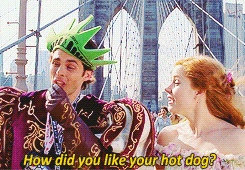
Has Just As Much Faith As the Princess -- One of the things Princes and Princesses use as the litmus test of whether or not they're soulmates in Disney movies is if they're both believers in the same Idea. Ariel and Eric are the perfect example. They both believe in something that everyone around them thinks is totally crazy. Eric believes in the fated, Right Girl. Ariel believes the Surface World can be worth loving. Those two things get united when they meet each other. Prince Edward longs to find the woman who's his other half, a companion who fits into his heart and makes his life more than just one quest after the other. (And he's so sweet about it.) He's very romantic. Giselle's been dreaming of her true companion, too. They have that in common, that faith that somebody right for them is out there. It just...so happens that that person isn't each other. But they're not wrong that someone is out there, which is why he is rewarded by winding up with Nancy.
Anyway. If Giselle is the Disney movie, so is Prince Edward.
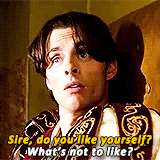
And yeah, he's not quick on the uptake, he's super confident that everything he's doing is right, and he's definitely convinced that Nathaniel actually likes him. But that is okay. Because Edward is uncomplicated. He knows that what he's setting out to do is Right, so what bothers him is never "people here are mean" or "I'm not the hero in this world." Did you notice that? He's never bothered when he finds out he's not the hero. He's only bothered when the idea that Good won't win is threatened.
He's the first one to turn and look at Robert and go "unless...!" excitedly when he realizes his own kiss isn't working. No trace of bitterness. No suspicion. Just eager to solve the problem.
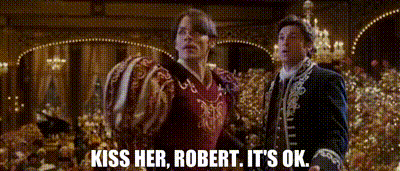
That's why he's great. His confidence came from being the champion of Goodness. Doing the right thing. He doesn't care if he's not the one who wins. He just cares that it's someone Good who's winning.
Then you have Nancy, who is the first of the "normal" people from our world to really give in to the idea of "True Love's Kiss" being a viable solution, right on the spot. Meaning there was space in her brain to believe in it.
I guess if I had to try to distill it, I'd say Nancy is just the reverse-Giselle. In the allegory (it's not all one-to-one) I would say...if Giselle (and to a lesser extent, Edward) is the Disney movie, and Robert is the skeptic, Nancy is us. She's not quite Giselle, not quite Robert...she's someone who wants to believe that the Disney Philosophy is true, but the problem is, nobody in our world believes it or acts like it.
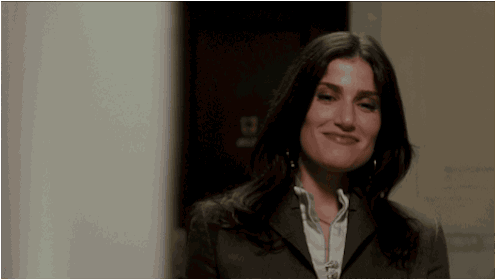
She's looking for a fairy tale but she's stuck in our world. The moments where she's happy with Robert are moments when he's doing something an open-hearted, genuine, selfless and chivalrous Disney Prince would do. The kind of guy who knows who he is and knows what's Good and values Love, so he isn't ashamed or insecure to come right out and declare it.
Gentleness is power, under control. A man in love should have no fear of vulnerability, which again, takes faith—because love isn't about you. It's selfless. Why worry about how telling a girl you love her will make you look, will make you feel? So what if she rejects you; you thought she was worth loving, you gave her that enormous compliment--so what if she doesn't return it? You know who you are. You didn't need her validation--that was never the point of the love-declaration--it was for her. You kindly gave her the world's best compliment, good job, now on to other worthy things. It would've been great if she wanted the same outcome of that love as you did, but she didn't, and that's great too, because it was never that much about you. So you don't have to be hurt, angry, embarrassed, jealous, or any of the anti-love things we associate with bogus unrequited "love."

But in our world, men don't act like that anymore. Because it's all about you. Can't tell the girl how you feel because she might hurt you. How would you be hurt? By finding out she doesn't feel the way you would prefer her to feel about you, by mocking what you've deemed precious, etc. It's all about you, you, you, fear fear fear, etc.
Still, you can tell Nancy thinks she got as close as she could to the fairy-tale guy with Robert because in her first scene, when she finds Robert and Giselle together, she goes on that rant about how she thought he was "sensitive" and "protecting Morgan." Those are the traits she's attracted to; the idea that he wasn't protecting himself, he was protecting his daughter--the idea that he was careful with emotions for other people's sake, not his own--that he cared about emotions at all.
But that's not what it was, it was self-protection, over-planning. Still, the second he's willing to send her flowers or make any kind of heart-on-his sleeve, straightforward gesture of affection, she is SO ready to believe in him again.
She's the grown up who wants to find the Disney fairy tale in "real life" and she's doing the best she can with what she can find. Kinda like a lot of us who grew up on Disney and didn't want to accept the derisive cynical mocking of Disney as we got older, but what could we do?
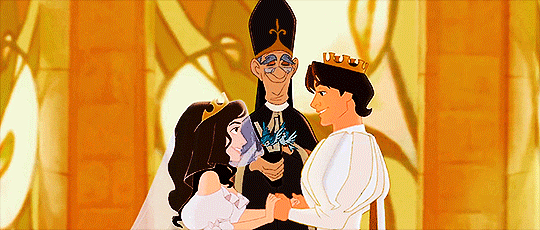
But good news! It's real! The Good, the Beautiful, the True, exists, and it comes for her.
Then you've got Narissa, the villainess.

She's interesting because she's totally the opposite of everything the movie says is Good. Giselle and Edward wear their hearts on their sleeves—Narissa manipulates people's fondest desires for her own gain. Robert needs to learn to have faith—Narissa believes everybody is out to take what's hers.
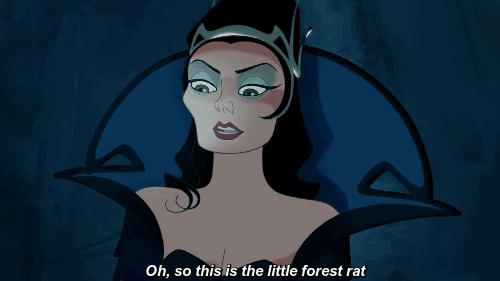
Edward gives the gift of love freely, first to Giselle, then, unshaken when she doesn't give him the same, to Nancy—Narissa takes the adoration of people like Nathaniel and treats them like garbage in return.
I also think Pip is important, and it's important that Narissa is defeated by him.
She's brought down by the tiny chipmunk who's been treated with true kindness and friendship by the Princess. The chipmunk who can talk and understand what's going on and be useful, even in a world where people like Robert think there's no such thing. Pip is the unlikely "something wonderful will happen" in our world that Robert didn't believe in. He's the little, fairy tale element that nobody could plan for or calculate or control, coming in to save the day.
How very Disney of him.
Ya'll get off of Wish. Disney's tribute to 100 years of fairy tale animation? It has nothing on Enchanted.
#Enchanted#enchanted meta#meta#analysis#character analysis#Prince Edward#Giselle#robert#Amy Adams#mcdreamy#narissa#Queen Narissa#pup#pip#Disney#the real Disney#Ariel#Eric#fairy tales#romance#romcom#Wish hate#wish 2023#Disney wish#wish movie#wish
132 notes
·
View notes
Text
Aulnoy's famous fairytales: The White Doe (2)
Now that we made a recap for the overall story, let's look at little details here and there, shall we?

1 ) Despite this being one of the most famous and reprinted fairytales of d'Aulnoy, The White Doe/The Hind in the Woods is one of the more dated of these stories. Not just because of the problematic racist elements of "princess Black of Ethiopia", but also because this story was clearly written in honor and reference to the king of the tme, Louis 14. When the fairies create a palace for princess Desired to live into until her fifteenth birthday, and have inside of it the whole history of the world depicted by art pieces, d'Aulnoy breaks her narration to describe in a poem form the "greatest and most brilliant warrior king of History", who is not named but is very clearly Louis XIV. Earlier, when the queen visited the six fairies' palace, the fairies told her that to build it they hired "the architect of the Sun", who basically recreated "the Sun's palace" but in smaller proportions. This is an obvious reference to Versailles, the wonderful castle of the "Sun-King", Louis 14. And if this wasn't enough, there are also several explicit comparisons to an actual historical event contemporary to the story: a royal wedding. Several times throughout the narration, d'Aulnoy says that the beautiful clothes or gorgeous outfits of Desired are identical with or "right behind in term of beauty" to the outfits and jewels worn at a "certain princess" wedding. These are all comparisons made to a certain woman named Marie-Adélaïde de Savoie, who had just married the duke of Bourgogne, aka... Louis XIV's grandchild.
All of this makes the story feel very NOT "intemporal" since, if you don't have the historical context, all those moments seem a bit weird and mysterious. And yet, this fairytale stayed one of d'Aulnoy's most popular ones... My guess is that what seduced people in this story was the imagery it brought rather than the story or writing itself. People's mind and imagination were struck by the supernatural white doe a prince cannot capture, by the visual of this monstrous crayfish terrorizing a queen and fairies by cursing a baby, by the idea of a beautiful girl doomed to live in the dark until her fifteenth birthday...
In fact, the way madame d'Aulnoy writes this tale to celebrate the royal wedding might explain why the main protagonist here, Desired, has such a young age - barely fifteen. Because Marie-Adélaïde de Savoie, upon being wed to Louis XIV's grandchild, was only twelve... [Note however that madame d'Aulnoy did not condone or enjoyed at all child-weddings of this sort - she herself had suffered from an atrocious arranged wedding in her very early life, and this ended up in a complicated business of manipulations, false accusations, exiles and murders - but when you live in 17th century France, you better be a propagandist of the king, especially if you are a woman who tries to write fiction.]
2 ) The beginning of the fairytale is obviously to put in parallel with Perrault's Sleeping Beauty. Same "gift-giving christening by the fairies" scene, the same way the older and more powerful of the fairies arrives to curse the babe only to have her curse "eased" by the others, the list of gifts offered by the fairies being quite similar to the one of the Sleeping Beauty fairies - more explicitely, in the beginning of Sleeping Beauty it was explicitely said the queen visited/tried several miraculous/healing waters to try to have a baby - which is what the queen does in the beginning of this tale, except here it becomes the start of the plot.
3 ) While there is still the manichean divide typical of French literary fairytales of "good fairy and wicked fairy", here d'Aulnoy plays deliberately on the fairies ambiguity, to show that despite acting by a binary pattern, fairies stay a "gray" set of beings. For example, the Fairy of the Fountain or Crayfish Fairy, despite being one of the main antagonists, starts out in the story as a helper and a benevolent force - and in a twist, still does fulfill her role of "good fairy godmother"... but she does so to the princess Black, who is an unwilling/accidental antagonist to the hero of the tale. (A similar process, where the antagonistic fairy is just the fairy godmother of someone other than the hero, was already used by d'Aulnoy in several of her previous fairytales, including The Blue Bird). As for the six benevolent fairies, while they are all good and nice throughout the story, the narration still highlights that they have two sets of chariots, and that when angered they drive the dragons, snakes and panther-driven chariots, hinting that while they are here helpers they can become antagonists in other stories.
4 ) While there is all the racism I talked about before, it is quite interesting to see here that we have two "anti-portraits" of ugly women, meant to oppose Desired's supreme beauty, two anti-portraits that actually help us understand the beauty criteria at work in this end of the 17th century of France. For Princess Black, we see that her ugliness comes from a "dark skin", "big lips" and a "crushed, large nose" - which are, beyond traits typically "African connoted", the opposite of the French ideal of women with very pale skin, very small noses, very thin lips. But in contrast, we also have Long-Thorn who presents another set of flaws. Just like princess Black there is the nose - here too red and too hooked - but beyond that we also have added poor teeth hygiene (Long-Thorn has black and unaligned teeth), and more interestingly a body too tall and too skinny. In general, when it comes to ugliness d'Aulnoy typically invokes smallness/dwarfism or fatness/obesity, but from time to time she also insists that when a character is too tall or too skinny, they also are ugly. Because in this time era, while they wanted women tall, they still didn't want them as tall as men, and there was still a certain "interest in the curve" as without being very large or big, women needed to be plump and fleshy enough to have a body to appreciate (a bony and skinny body was not a beautiful one at the time). Of course, no need to remind you that this was a set of aristocratic ideals - because only the noble and the rich could afford to be chalk-white and "pleasantly plump".
5 ) People have noted that, funnily, the way prince Warrior falls asleep in the woods after eating apples he found there looks like a "male Snow-White". It is quite interesting because, while there probably wasn't a Snow-White reference (since it is not a typically French tale), madame d'Aulnoy had the very Christian background and culture of the apple as the "forbidden fruit" with the whole Garden of Eden story. Which leads to an interesting point...
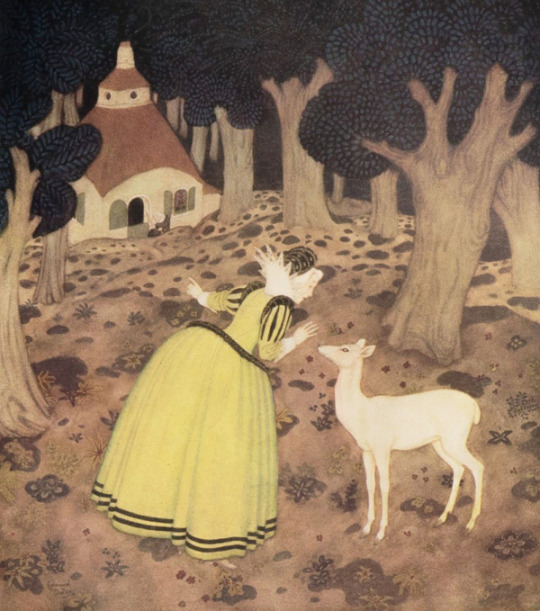
6 ) This fairytale is a sexy tale. It is not an overtly erotic fairytale, no, but there is an obvious VERY romantic if not sexy if not erotic connotation. This however only appears in the second half of the story, when Desired becomes the White Doe. Desired, turned into a prey, and Warrior, improvising himself a hunter, those two lovers, find themselves reunited deep into the woods (the uncivilized, savage, wild world) after purposefully leaving or fleeing their respective courts (the forest is noted to be filled with dangerous predatory animals, such as bears or lions). Warrior hunts down the White Doe, not knowing that she is the girl he is in love with and obsessed over - though he also grows a fondness, familiarity and love for this white doe. And all the while, the White Doe recognizes her hunter as the one she is in love with, and having to flee from him for her life is said to be just as painful as if she was actually hit by his arrows... Madame d'Aulnoy clearly plays here on metaphors and allegories to weave a whole "game of love" or "love as the hunt", "hunt as the love" section. Warrior hunting for the White Doe, the White Doe making sure she can be hunted while never letting herself be caught, it all evokes a bizarre game of seduction. Warrior clearly treats the Doe as more than a simple pet, claiming he "loves" it and wants it to follow him everywhere and to live with him. When the Doe tricks Warrior to escape him, and Warrior complains to his friend, Becafigue jokes about the situation being like an unfaithful woman cheating on her lover - but the prince answers his joke absolutely seriously. And of course, it is after the prince and the princess spend the night together, sharing their love, in human form, that the spell is broken... [Note: In my previous recap I might have written things backward, saying the spell is broken when "night comes and nothing happens". It is the reverse - they talk all ight long together, and as the morning comes she doesn't transform. Sorry about that.]
Beyond the general image, if things weren't clear eough d'Aulnoy keeps addng little details that make the story even more erotic - almost scandalous. The apple section I mentionned - prince Warrior eating apples in the woods before falling deeply asleep reminds of the first human consuming the "forbidden fruit", and it is when the White Doe dares sleep near him for the first time. When the prince catches the Doe or tries to "woo" it with gifts, it is said he keeps petting it, hugging it, caressing it, kissing it - as a pet, as an animal of course, but we reader know that there is a human woman underneath this doe skin, and so the erotic content cannot be escaped. ESPECIALLY when it is said that, after running from each other all day long, both return to their respective bedrooms "sweating and panting, exhausted by the time they spent together". And don't even get me started on how the prince ends up, to conquer and tie up the doe, hitting her with a single arrow in the leg, making her bleed... This is not a fairytale safe for kids.
7 ) Speaking of love, I did not mention it in my recap, but this fairytale is one of the rare ones of d'Aulnoy to have a moral in the end. To summarize it, d'Aulnoy explains that "With the story of this princess that wanted to leave too soon the dark place a wise fairy placed her in to hide her from the sun's light - and the metamorphosis and misfortunes that resulted from it - you will find an illustration of the dangers to which a young beauty exposes herself when she enters too young, too unprepared in the world. If you were gifted with all the traits and qualities that attract love to you, you better know how to hide them, because beauty can be deadly. If you think that by making others fall in love with you, you will shield yourself from love, well know that by giving too much, you always end up taking." So yes, long story short, this is meant to be more than just a fairy love story, but a warning for girls that too young, too beautiful, too unprepared, throw themselves in the world of love, adult and serious romance, and have to be confronted with the many dangers in it.
8 ) On a more "traditional love story" side, this fairytale accumulates ALL the story devices typical of romances of the type to avoid having the two lovers meet each other. In fact, this is the entire point of this story, the apex and climax and culmination: when princess Desired and prince Warrior can finally see each other in person, and talk to each other. At first you had the exchange of portraits and the sending of ambassadors, then you had the fake princess Long-Thorn hijacking the planned meeting, then the two lovers finally got under the same roof, but not only ignored each other's existence, even when meeting each other they didn't recognize themselves thanks t the doe curse... So when they finally see themselves as humans and touch each other as humans and talk a full dialogue, the story is complete and the curse is broken

9 ) Note however that despite the seemingly virtuous and chaste moral added at the end, madame d'Aulnoy does write the character of a more proactive and manipulative princess that "plays" her male lover. It is she that is happy with his caresses and petting and allows herself to be "touched" of the sort, and it is she that sneaks up by her lover's asleep body, and again the terms of the curse are clear - by day she is forced to become a beast, and to do as beasts do, aka to wander in the woods, aka to return to the world of savagery, primal desire and bestial behavior. On the other side, something that might escape a reader at first glance is that prince Warrior is not supposed to be a "prince Charmng" of the traditional genre. As I said, we are inside d'Aulnoy's second book of fairy tales, and so she reached a point where she plays with the conventions of the genre. In the whole hunt story, we have a brutal lover who tries to kill, seriously wounds though he heals it afterward) and ties up with knots his lover, treating her like a prey and a beast (well, because she IS, but you know) - and there is also the use of the peep-hole by Becafigue that solves the whole problem indeed, but by the undignified way of spying into women's bedrooms (Becafigue had already a not so good behavior when he acted as Warrior's ambassador, encouraging Desired's parents to ignore the "powerless" and "silly fairies" and disobey Tulip's warnings - and in the world of fairy tales one should NEVER underestimate the power of fairies)
But that's just for the second part of the story. In the first part, prince Warrior's behavior is also to be criticized. In fact, it is quite ironic that he is called "Warrior" and introduced as the winner of "three battles", because the first part of his character act has him acting as un-warrior, if not un-manly as possible. He becomes a love-stricken mess, he locks himself in his room talking to a portrait, he despairs of not being able to be with his love, he spends his day dreaming, and doing nothing, and wasting away, with no appetite for anything, making himself sick over lethargy and depression - and so fragile that he can't even wait three months for his loved one to come without fearing he would die. And even worse, when his hopes and dreams of love are crushed, he acts as a selfish coward by simply abandoning his parents, his throne, his court and duties, leaving secretly at night with just one letter behind to explain everything to his parents, and isolating himself from the world in desire to just cry on his own fate forever in some isolated place... We've got some emo teen in love vbes here.
10 ) This fairytale is very "medieval" like in tone. Beyond the "fairy christening" scene that is reused everywhere ever since Perrault and inherits from similar medieval scenes, a la Perceforest, the entire topic of the hunter going after a supernatural, white animal he cannot capture is an iconic topos of medieval literature. Typically this doubles or is tied to the hunter meeting some mysterious woman in the woods, preferably near a fountain, who might take him to a wonderful palace - but this happens rather to Desired's mother, who meets a fairy at a fountain, and is then taken to the six fairies' magical castle.
11 ) In terms of folkloric inspiration, if we use the Catalogue Delarue-Tenèze (a local form of the ATU Index but exclusively covering French fairytales), this story is clearly a literary take on the story type 403, "The substituted fiancee", "The fake fiancee". More specifically, it is a literary take on the 403-B (characterized by the metamorphosis of the real fiancee replaced by a fake one), though there is one element typical of the 403-A (the fact that the prince falls in love with a portrait). While inspired by it, madame d'Aulnoy clearly adds several purely literary elements that make this story very unique. For example the scene of the "fairy-gifts" and the "fairy-curse" at Desired's birth, or the presence of a first fiancee for the prince in the person of the princess Black, two elements united by the character of the Crayfish Fairy or Fairy of the Fountain - this all comes from d'Aulnoy's mind, and is traditonnaly not found in French folktales. And this was clearly placed here only to complicate the originally straightforward story into something much more focused on a "twist-and-turn romance".
#the white doe#the hind of the woods#french fairytales#literary fairytales#french fairy tales#madame d'aulnoy#d'aulnoy fairytales#fairytale analysis
121 notes
·
View notes
Text
I've decided not to write any more long posts about why some people don't like Disney's Belle. I've probably been dwelling too much in other people's negative thoughts that I disagree with. But here are the rest of the critiques of Belle's character that I've read, and my short, succinct thoughts on each one.
I still think it's very interesting that some critics think Belle is too sweet and gentle, too feminine, and not "strong" or "modern" enough, while others think she's too defiant, too "modern," and not sweet or gentle enough.
Her desires at the beginning are ill-defined: she wants "adventure" and "more," but has no specific goal. This is true, but personally, I don't mind it. Plenty of us don't know exactly what we want from life, but do know that we want more excitement and wonderment.
She does nothing but read and complain in the village; she makes no effort to achieve her dreams of adventure, and she never does any realistic peasant chores, which makes her come across even more as a spoiled rich girl. I think it's implicit that Belle and Maurice are too poor to leave the village – that's why Maurice sets out to gain fame and fortune with his invention. And I think Belle's never doing housework onscreen was part of Linda Woolverton's feminist agenda. Maybe it's not realistic, and maybe it's overly "second wave feminist," but I do think it was fair of Woolverton to want to break away from the Walt-era Princess model and not show Belle cooking or cleaning.
Her dreams of adventure are side-swept in favor of a mere love story. I think there are two ways of addressing this issue. One is to argue that her dreams of adventure do come true, just in a way she never expected. The other, supported more by the song "A Change in Me" from the musical, is that she does lose her dreams, but for the better, as she realizes her life doesn't need to be like a romantic storybook to be happy.
Her romance with the Beast isn't nearly as fleshed-out or as realistic as fans claim it is. This is subjective. Some people think it's one of the best-written romance arcs in cinema.
She affects meek politeness and plays games with Gaston instead of plainly refusing his advances. First of all, if Belle didn't care about politeness, she would be a hypocrite to criticize Gaston and the Beast for their rudeness. Secondly, Gaston is intimidating. Third, this is only the beginning of her journey – with the Beast, she arguably learns to stand up to someone who mistreats her, which lets her decisively reject Gaston and call him a monster later on.
She seems to blindly love all books without questioning their content, which could be dangerous, especially when the French Revolution arrives. Belle has no trouble thinking for herself. If she can open her heart and mind to the Beast, and loathe Gaston while the rest of the town adores him, then I'm sure she can tell good books apart from bad and dangerous books. And the fashions in the movie are such a mish-mosh that I'm not sure if it takes place before the French Revolution or after... or if the French Revolution will even happen in this fairy tale world.
She sacrifices her own needs for men. Yes she does, but it's not framed in a gendered way, and both the Beast and Maurice do the same for her.
She emasculates the Beast. Well, I'll admit that the Beast's arc isn't very empowering for him – that's the whole point, that he learns to give up some of his personal power and love unselfishly. But is that necessarily a bad thing? I'll also admit that sometimes, I feel troubled that the Beast lets the mob attack the castle and does nothing to protect his servants. Still, we probably shouldn't judge a character whose mental health is clearly suffering at this point: immobilizing, suicidal despair doesn't only exist in fiction, so we should think twice before we call it "weakness" or "emasculation."
She needs male characters to rescue her – the Beast from the wolves, Chip from the cellar. I respect the complaint that the Disney Renaissance movies still rely too much on the "boy rescues girl" trope, but there's no shame in needing to be rescued. Especially because in the forest scene, Belle is just one human facing a whole pack of wolves, and in the cellar scene, her father is rescued too.
She never uses her skills, knowledge, or passions to solve problems – the only purpose they serve is to unite her with the Beast. I think this is just a genre problem. The whole story is geared toward uniting Belle and the Beast in love, and every story beat serves that end.
She almost leaves the Beast to die in the snow and stays angry about the West Wing incident even after he saves her life. The former is only a split second, while the latter is only in self-defense when the Beast unfairly blames her for his injury. Besides, consider the context of how the Beast has behaved until this point!
She's a hypocrite for giving the Beast a second chance yet dismissing Gaston as a monster. She doesn't give the Beast a chance until he risks his life to save hers. If Gaston had done anything like that, she would have given him a second chance too, but he doesn't. Gaston is also far more cold-blooded and narcissistic than the Beast ever is.
She's to blame for the Beat's near-death at the climax because she reveals his existence to Gaston and the other villagers. Of course she is. It's explicitly framed as a terrible mistake and she openly blames herself. But it's an impulsive act of desperation to save her father, and she tries to explain that the Beast is kind and gentle. Until it's too late, it clearly doesn't cross her mind that the villagers could form a mob to kill him!
She plays a nurturing, motherly role to both the Beast and her father. I agree that heroines shouldn't need to be nurturing. But it's not inherently anti-feminist to be that way!
She's sidelined in the final battle. Yes, this is true, but her presence is still essential to the scene, and not every heroine needs to be an action girl.
Her portrayal falls short of the original Beauty's greatest virtues: her kindness, selflessness, and compassion. Belle still has those qualities, they're just combined with more "modern" ones (adventurousness, defiance toward unjust authority figures, etc.). Besides, Disney had already made several excellent movies about heroines defined by kindness and gentleness. What's wrong with giving Belle a slightly different set of virtues?
She's too traditionally feminine and ladylike. I think most of us can agree that "femininity" ≠ "anti-feminist," and anyone who thinks that way is a little misguided.
Her creators glorify her at the expense of the other Disney Princesses. I agree that it was unfair and mean-spirited of Linda Woolverton to imply that the three Walt-era Princesses are "insipid," but I do respect her insistence on making Belle a different, more "modern" heroine. And I agree that Paige O'Hara was mistaken when she described Belle as "the first Princess not looking for a man" (neither Cinderella nor Ariel dream of romance until they actually meet their princes), but I don't hold that against Belle.
She's too blatantly written as a role model – she doesn't feel like a real person, but like a living instruction manual for how a "smart," "empowered" woman should behave. This is valid. But I personally do think she seems like a real person as well as a role model, and I think she's engaging enough that I don't mind the obvious "role model" qualities.
69 notes
·
View notes